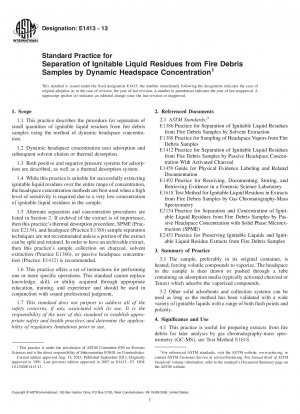ASTM E1413-13
Standard Practice for Separation of Ignitable Liquid Residues from Fire Debris Samples by Dynamic Headspace Concentration
- Standard No.
- ASTM E1413-13
- Release Date
- 2013
- Published By
- American Society for Testing and Materials (ASTM)
- Status
- Replace By
- ASTM E1413-19
- Latest
- ASTM E1413-19
- Scope
4.1 This practice is useful for preparing extracts from fire debris for later analysis by gas chromatography-mass spectrometry (GC-MS), see Test Method E1618.
4.2 This is a very sensitive separation procedure, capable of isolating quantities smaller than 0.1 μL of ignitable liquid residue from a sample
4.2.1 Actual recovery will vary, depending on several factors, including adsorption temperature, container size, and competition from the sample matrix.
4.3 This is a potentially destructive technique. Portions of the sample subjected to this procedure may not be suitable for re-sampling. Therefore, a portion of the sample extract should be saved for potential future analysis. Consider using passive headspace concentration as described in Practice E1412.
1.1 This practice describes the procedure for separation of small quantities of ignitable liquid residues from fire debris samples using the method of dynamic headspace concentration.
1.2 Dynamic headspace concentration uses adsorption and subsequent solvent elution or thermal desorption.
1.3 Both positive and negative pressure systems for adsorption are described, as well as a thermal desorption system.
1.4 While this practice is suitable for successfully extracting ignitable liquid residues over the entire range of concentration, the headspace concentration methods are best used when a high level of sensitivity is required due to a very low concentration of ignitable liquid residues in the sample.
1.5 Alternate separation and concentration procedures are listed in Section 2. If archival of the extract is of importance, then this practice’s thermal desorption procedure, SPME (Practice E2154), and headspace (Practice E1388) sample separation techniques are not recommended unless a portion of the extract can be split and retained. In order to have an archivable extract, then this practice’s sample collection on charcoal, solvent extraction (Practice E1386), or passive headspace concentration (Practice E1412) is recommended.
1.6 This practice offers a set of instructions for performing one or more specific operations. This standard cannot replace knowledge, skill, or ability acquired through appropriate education, training, and experience and should be used in conjunction with sound professional judgment.
1.7 This standard does not purport to address all of the safety concerns, if any, associated with its use. It is the responsibility of the user of this standard to establish appropriate safety and health practices and determine the applicability of regulatory limitations prior to use.
ASTM E1413-13 Referenced Document
- ASTM E1386 Standard Practice for Separation and Concentration of Ignitable Liquid Residues from Fire Debris Samples by Solvent Extraction
- ASTM E1388 Standard Practice for Sampling of Headspace Vapors from Fire Debris Samples
- ASTM E1412 Standard Practice for Separation of Ignitable Liquid Residues from Fire Debris Samples by Passive Headspace Concentration With Activated Charcoal
- ASTM E1459 Standard Guide for Physical Evidence Labeling and Related Documentation
- ASTM E1492 Standard Practice for Receiving, Documenting, Storing, and Retrieving Evidence in a Forensic Science Laboratory
- ASTM E1618 Standard Test Method for Ignitable Liquid Residues in Extracts from Fire Debris Samples by Gas Chromatography-Mass Spectrometry
- ASTM E2154 Standard Practice for Separation and Concentration of Ignitable Liquid Residues from Fire Debris Samples by Passive Headspace Concentration with Solid Phase Microextraction (SPME)*, 2024-04-20 Update
- ASTM E2451 Standard Practice for Preserving Ignitable Liquids and Ignitable Liquid Residue Extracts from Fire Debris Samples
ASTM E1413-13 history
- 2019 ASTM E1413-19 Standard Practice for Separation of Ignitable Liquid Residues from Fire Debris Samples by Dynamic Headspace Concentration onto an Adsorbent Tube
- 2013 ASTM E1413-13 Standard Practice for Separation of Ignitable Liquid Residues from Fire Debris Samples by Dynamic Headspace Concentration
- 2007 ASTM E1413-07 Standard Practice for Separation and Concentration of Ignitable Liquid Residues from Fire Debris Samples by Dynamic Headspace Concentration
- 2006 ASTM E1413-06 Standard Practice for Separation and Concentration of Ignitable Liquid Residues from Fire Debris Samples by Dynamic Headspace Concentration
- 2000 ASTM E1413-00(2005) Standard Practice for Separation and Concentration of Ignitable Liquid Residues from Fire Debris Samples by Dynamic Headspace Concentration
- 2000 ASTM E1413-00 Standard Practice for Separation and Concentration of Ignitable Liquid Residues from Fire Debris Samples by Dynamic Headspace Concentration
